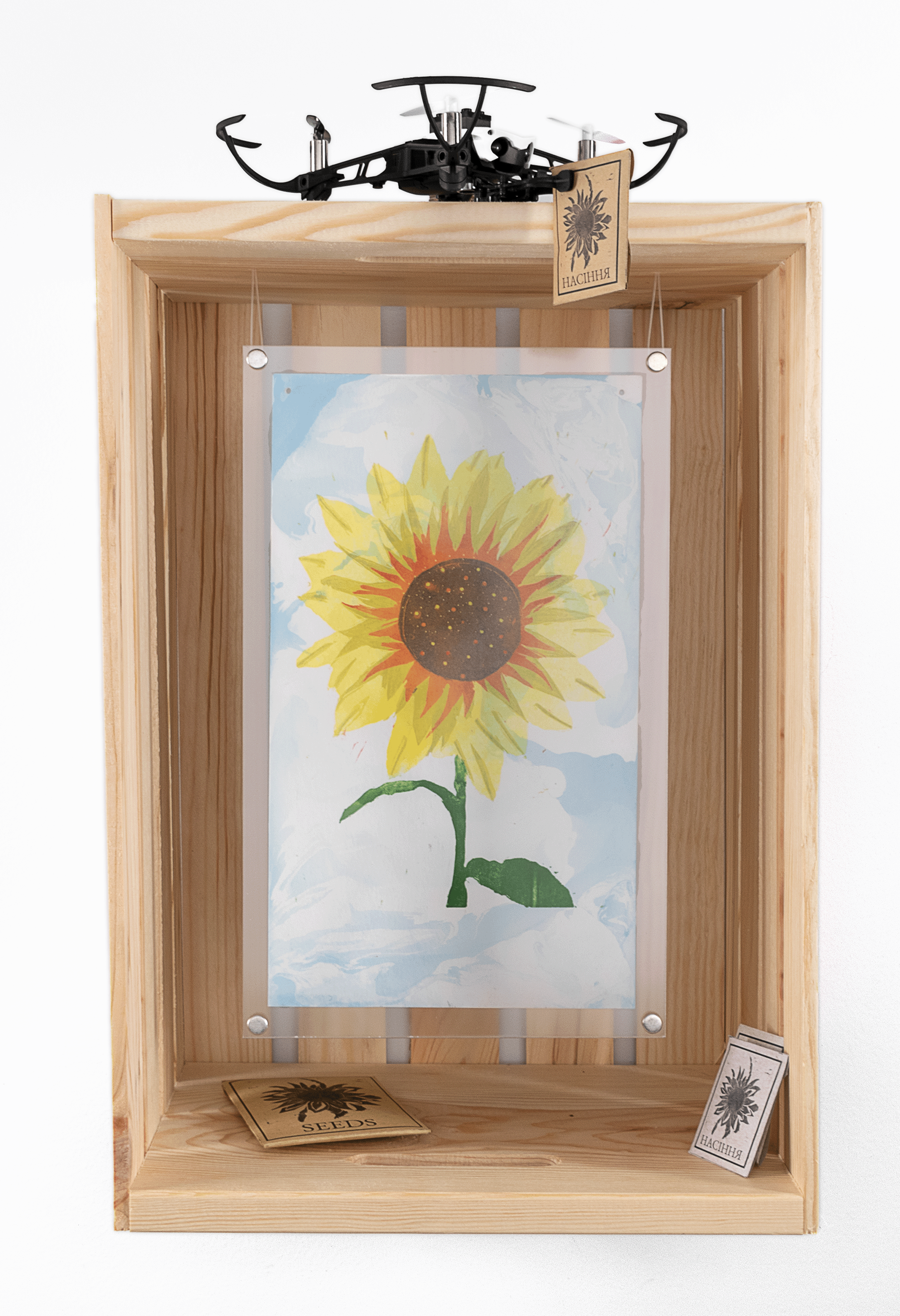Variation #21
By KS Lack
Print: Variated Proof 5/5
Frame: drone, sunflower-seed packets, wood crate
Both Russia and Ukraine have used drones extensively across all spheres of combat. Ukrainian soldiers began using drones at the start of the invasion.(A) Inexpensive commercial racing drones, when retrofitted with explosives, proved highly effective as improvised missiles. These First Person View (FPV) drones are equipped with a small cameras and are guided by operators via remote control. Although FPV drones are only effective at limited distances, frontline soldiers quickly realized their potential and began experimenting. Today, various types of retrofitted FPV drones are used not only as kamikaze weapons but also for reconnaissance missions and as multi-use bombers. Naval drones have also been successfully employed against Russia’s Black Sea Fleet, with estimates suggesting Ukraine has managed to sink about third of the fleet.
Russia initially utilized drones in a more traditional manner, deploying them as medium- to long-range reconnaissance and attack weapons specifically designed for military use. Russian drones come in a various forms and are integrated into Russia’s aerial assaults, such as the massive attack on August 26, which involved over 200 drones and missiles and struck 15 different Ukrainian regions.(B) Unfortunately, Russia has learned from Ukraine’s tactics and has now begun incorporating FPV drones into its own frontline strategy.
As a result, the 800+ mile front line is now saturated with small aerial drones. Both sides have deployed Electronic warfare (EW) systems to jam the radio signals used to operate the FPV drones, often causing them to crash before reaching their targets. In response, Ukraine and Russia are racing to develop drones guided by artificial intelligence (AI), with AI systems reportedly being by used in limited numbers by both sides. Russia has also begun experimenting with controlling drones over short distances using fiber-optic cables.
During the first year of the war, most of the FPV drones used by Ukraine were either donated or purchased through crowdsourcing; the first successful naval drones were created by civilian volunteers. Kyiv has since significantly ramped up drone development funding, resulting in the creation of the Magaura, a seaborne drone credited with damaging or destroying over two dozen Russian ships, and the long-range Ukrjet drones, capable of targeting facilities deep within Russia.(C)
The very definition a drone is expanding, as evidenced by the “drone dogs” currently under development in the US. These robots are at the forefront of efforts to locate and remove landmines using drones.(D) Perhaps one day drones—currently so symbolic of war—will instead become emblems of peace.
A) For more on the ingenuity of Ukraine’s soldiers, see Variation #16.
B) For more on Russia’s bombing campaigns, see Variation #6 & #18.
C) For more on Ukraine’s innovative use of marine weaponry, see Variation #11.
D) For more on landmines, see Variation #22.
See below for further reading and background.
The Most Important Drone Battles are Yet to Come. Is Ukraine Ready?, ZN,UA, 27 Aug 24.
Ukraine Has No Navy. But It’s Hammering Russia In The Black Sea, RFE/RL, 19 Feb 24.
Russia’s deadly overnight barrage of missiles and drones hits over half of Ukraine, APNews, 26 Aug 24.
The Real AI Weapons Are Drones, Not Nukes, The Atlantic, 01 Feb 24.
Russian Fiber Optic Drone Beats Any Jammer, Forbes, 18 March 24.
The Drone Wars: How Ukraine Beat Russia in the Battle of the Black Sea, Time, 26 Aug 24.
How drone combat in Ukraine is changing warfare, Reuters, 26 Mar 24.
Not Only for Killing: Drones Are Now Detecting Land Mines in Ukraine, The New York Times, 24 Aug 24.


